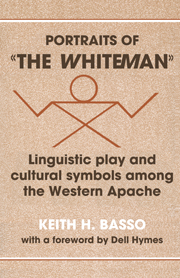Book contents
3 - Joking imitations of Anglo-Americans: interpretive functions
Published online by Cambridge University Press: 05 July 2015
Summary
What the white man doesn't realize is the tenacity of Indians. They simply don't realize the utter individuality of Indian people and their belief in one thing more than absolutely anything else: being Indian.
—Fritz Scholder (Interview, Song from the Earth: American Indian Painting)My interpretation of Western Apache joking imitations proceeds on the twin assumptions that joking is a form of play, and that play is characterized by a paradox of the Russellian, or Epimenides, type, consisting in a negative statement that contains within it an implicit negative metastatement (Bateson, 1972). Accordingly, acts of play may be defined as those which are modeled on acts that are “not play,” but which are understood not to communicate what would be communicated by these acts if they were performed unplayfully. So it is with joking. Acts of joking convey messages that are not conveyed when the acts they are patterned after are performed unjokingly, and for this reason jokes are not intended to be taken literally, “seriously,” or at face value (Austin, 1962:121). In the event that they are, they instantly cease being jokes and, having thus gone awry, stand open to interpretation as instances of the un joking acts they are modeled upon. The social consequences of such interpretations may be sharply disruptive, for the acts that jokes most closely resemble – the acts they are patterned after but are not intended to be – are slurs, criticisms, and insults (Radcliffe- Brown, 1940; Labov, 1972). Western Apaches express their own understanding of these conditions by observing that jokes are simultaneously ‘funny’ (dabagodlohé) and ‘dangerous’ (benagodzig'). In order to appreciate what is meant by this assertion – and why, more specifically, Apaches maintain that it applies with particularly telling force to joking imitations of Anglo-Americans – we must look again at the manner in which these imitations are performed and consider more closely the kinds of transformations they entail.
- Type
- Chapter
- Information
- Portraits of 'the Whiteman'Linguistic Play and Cultural Symbols among the Western Apache, pp. 35 - 64Publisher: Cambridge University PressPrint publication year: 1979



